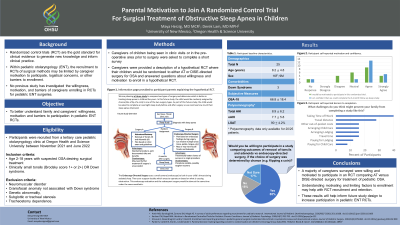Pediatric Otolaryngology
(320) Motivation to Join Pediatric RCT for Surgical Treatment of OSA
Monday, October 2, 2023
2:45 PM - 3:45 PM East Coast USA Time

- MH
Maya Herzig, MD MCR
PGY-1
University of New Mexico
Albuquerque, New Mexico, United States - DL
Derek Lam, MD MPH
Associate Professor
Oregon Health & Science University
Portland, Oregon, United States
Presenting Author(s)
Senior Author(s)
Disclosure(s):
Maya Herzig, MD MCR: No relevant relationships to disclose.
Introduction: Randomized control trials (RCT) are the gold standard of clinical evidence to generate new knowledge and clinical practice standards. Within pediatric otolaryngology (ENT), the recruitment to RCTs of surgical methods may be limited by caregiver motivation to participate or other barriers to enrollment. No previous study has investigated the motivating and limiting factors of caregivers enrolling in RCTs for pediatric ENT surgeries.
Methods: Caregivers of patients with obstructive (OSA) were recruited from a tertiary pediatric ENT clinic between November 2021 and June 2022. Participants were eligible if the patient was aged 2-18 years, clinical or polysomnographic (PSG) OSA, 1+ or 2+ tonsils OR down syndrome, and planned for adenotonsillectomy or DISE-directed surgery. Caregivers completed surveys of demographic information and were provided a description of AT and DISE-directed surgery for OSA and answered questions about willingness and motivation to enroll in a hypothetical RCT.
Results: Twenty-five subjects completed baseline surveys (Mean age 8.2 years, 16 female, 3 Down Syndrome). When asked “Would you be willing to participate in a study comparing outcomes of removal of tonsils and adenoids vs endoscopy-directed surgery, if the choice of surgery was determined by chance (e.g. flipping a coin)? This is called a Randomized Clinical Trial,” 60% of participants were willing to be randomized between AT and DISE-directed surgery (15/25 yes, 4/25 not sure, 4/25 no, and 2/25 did not respond), and 52% reported motivation to complete the randomized study (13/25 agree or strongly agree, 6/25 neutral, 4/25 disagree, 2/25 did not respond). Taking time off work and travel distance were cited as the most anticipated barriers to completing the study.
Conclusions: A majority of caregivers surveyed were willing and motivated to participate in an RCT comparing AT versus DISE-directed surgery for treatment of pediatric OSA. Understanding motivating and limiting factors to enrollment will help RCT recruitment and retention. These results will help inform future study design to increase participation in pediatric ENT RCTs.
